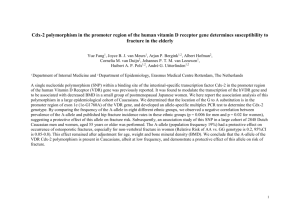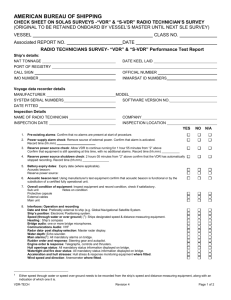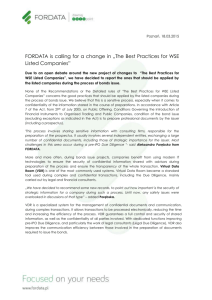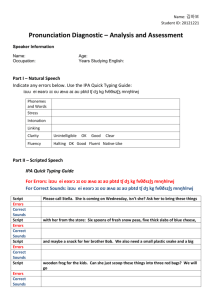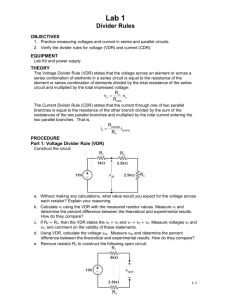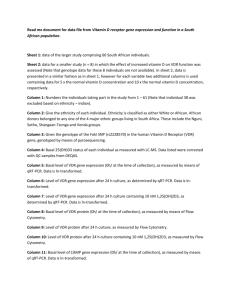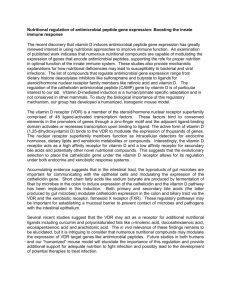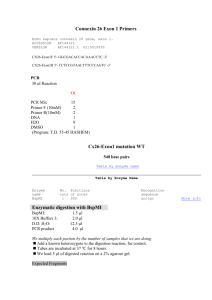Alternative Exon 3 Inclusion in the Vitamin D Receptor (VDR)... Activity for Target Genes in a Ligand-Independent Manner.
advertisement
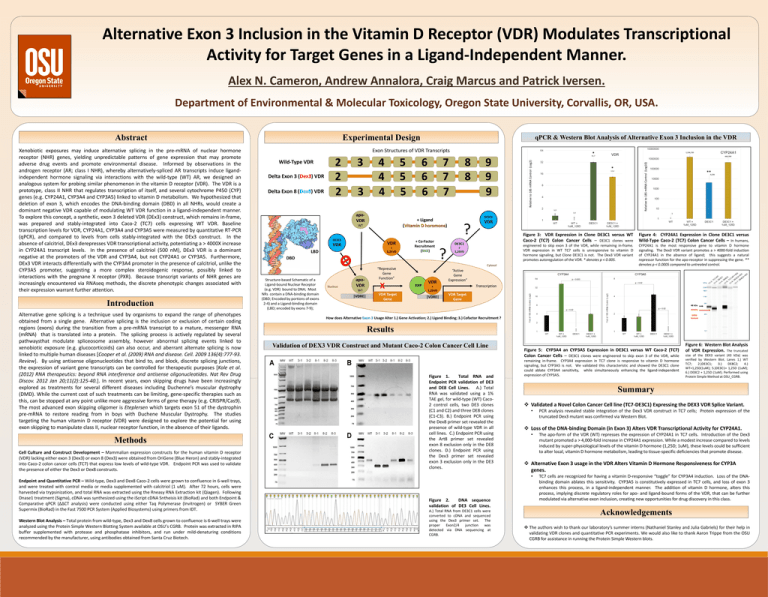
Alternative Exon 3 Inclusion in the Vitamin D Receptor (VDR) Modulates Transcriptional Activity for Target Genes in a Ligand-Independent Manner. Alex N. Cameron, Andrew Annalora, Craig Marcus and Patrick Iversen. Department of Environmental & Molecular Toxicology, Oregon State University, Corvallis, OR, USA. Experimental Design Introduction Alternative gene splicing is a technique used by organisms to expand the range of phenotypes obtained from a single gene. Alternative splicing is the inclusion or exclusion of certain coding regions (exons) during the transition from a pre-mRNA transcript to a mature, messenger RNA (mRNA) that is translated into a protein. The splicing process is actively regulated by several pathwaysthat modulate spliceosome assembly, however abnormal splicing events linked to xenobiotic exposure (e.g. glucocorticoids) can also occur, and aberrant alternate splicing is now linked to multiple human diseases [Cooper et al. (2009) RNA and disease. Cell. 2009 136(4):777-93. Review]. By using antisense oligonucleotides that bind to, and block, discrete splicing junctions, the expression of variant gene transcripts can be controlled for therapeutic purposes [Kole et al. (2012) RNA therapeutics: beyond RNA interference and antisense oligonucleotides. Nat Rev Drug Discov. 2012 Jan 20;11(2):125-40.]. In recent years, exon skipping drugs have been increasingly explored as treatments for several different diseases including Duchenne’s muscular dystrophy (DMD). While the current cost of such treatments can be limiting, gene-specific therapies such as this, can be stopped at any point unlike more aggressive forms of gene therapy (e.g. CRISPR/Cas9). The most advanced exon skipping oligomer is Eteplersen which targets exon 51 of the dystrophin pre-mRNA to restore reading from in boys with Duchene Muscular Dystrophy. The studies targeting the human vitamin D receptor (VDR) were designed to explore the potential for using exon skipping to manipulate class II, nuclear receptor function, in the absence of their ligands. Methods Cell Culture and Construct Development – Mammalian expression constructs for the human vitamin D receptor (VDR) lacking either exon 3 (Dex3) or exon 8 (Dex3) were obtained from OriGene (Blue Heron) and stably-integrated into Caco-2 colon cancer cells (TC7) that express low levels of wild-type VDR. Endpoint PCR was used to validate the presence of either the Dex3 or Dex8 constructs. Exon Structures of VDR Transcripts Wild-Type VDR Delta Exon 3 (Dex3) VDR Delta Exon 8 (Dex8) VDR 2 2 2 3 3 4 4 4 5 5 5 apoVDR 6 6 6 7 7 7 + Ligand (Vitamin D horomone) WT DE3C1 VDR VDR + 1,25VD LBD + Co-Factor Recruitment (RXR) DBD Structure-based Schematic of a Ligand-bound Nuclear Receptor (e.g. VDR) bound to DNA; Most NRs contain a DNA-binding domain (DBD; Encoded by portions of exons 2-4) and a Ligand-binding domain (LBD; encoded by exons 7-9); Nucleus apoVDR WT |VDRE| VDR Target Gene 8 8 9 9 9 RXR VDR ? + 1,25VD Figure 3: VDR Expression in Clone DE3C1 versus WT Caco-2 (TC7) Colon Cancer Cells – DE3C1 clones were Figure 4: CYP24A1 Expression in Clone DE3C1 versus Wild-Type Caco-2 (TC7) Colon Cancer Cells – In humans, engineered to skip exon 3 of the VDR, while remaining in-frame. VDR expression in WT TC7 cells is unresponsive to vitamin D hormone signaling, but Clone DE3C1 is not. The Dex3 VDR variant promotes autoregulation of the VDR. * denotes p < 0.005. CYP24A1 is the most responsive gene to vitamin D hormone signaling. The Dex3 VDR variant promotes a > 4000-fold induction of CYP24A1 in the absence of ligand; this suggests a natural repressor function for the apo-receptor in suppressing the gene. ** denotes p < 0.0005 compared to untreated control. “Active Gene Expression” Transcription + 1,25VD |VDRE| VDR Target Gene 48 kDa 43 kDa DEX3 Variant How does Alternative Exon 3 Usage Alter 1.) Gene Activation; 2.) Ligand Binding; 3.) Cofactor Recruitment ? Results Validation of DEX3 VDR Construct and Mutant Caco-2 Colon Cancer Cell Line Figure 1. Total RNA and Endpoint PCR validation of DE3 and DE8 Cell Lines. A.) Total RNA was validated using a 1% TAE gel, for wild-type (WT) Caco2 control cells, two DE3 clones (C1 and C2) and three DE8 clones (C1-C3). B.) Endpoint PCR using the Dex8 primer set revealed the presence of wild-type VDR in all cell lines. C.) Endpoint PCR using the Art8 primer set revealed exon 8 exclusion only in the DE8 clones. D.) Endpoint PCR using the Dex3 primer set revealed exon 3 exclusion only in the DE3 clones. Figure 5: CYP3A4 an CYP3A5 Expression in DE3C1 versus WT Caco-2 (TC7) Colon Cancer Cells – DE3C1 clones were engineered to skip exon 3 of the VDR, while remaining in-frame. CYP3A4 expression in TC7 clone is responsive to vitamin D hormone signaling, but CYP3A5 is not. We validated this characteristic and showed the DE3C1 clone could ablate CYP3A4 sensitivity, while simultaneously enhancing the ligand-independent expression of CYP3A5. Western Blot Analysis – Total protein from wild-type, Dex3 and Dex8 cells grown to confluence is 6-well trays were analyzed using the Protein Simple Western Blotting System available at OSU’s CGRB. Protein was extracted in RIPA buffer supplemented with protease and phosphatase inhibitors, and run under mild-denaturing conditions recommended by the manufacturer, using antibodies obtained from Santa Cruz Biotech. Figure 2. DNA sequence validation of DE3 Cell Lines. A.) Total RNA from DE3C1 cells were converted to cDNA and sequenced using the Dex3 primer set. The proper Exon2/4 junction was detected via DNA sequencing at CGRB. Figure 6: Western Blot Analysis of VDR Expression. The truncated size of the DEX3 variant (43 kDa) was verified by Western Blot. Lanes 1.) WT TC7; 2.)DE3C1; 3.) DE8C2; 4.) WT+1,25D(1uM); 5.)DE3C1+ 1,25D (1uM); 6.) DE8C2 + 1,25D (1uM). Performed using Protein Simple Method at OSU_CGRB. Summary Validated a Novel Colon Cancer Cell line (TC7-DE3C1) Expressing the DEX3 VDR Splice Variant. • PCR analysis revealed stable integration of the Dex3 VDR construct in TC7 cells; Protein expression of the truncated Dex3 mutant was confirmed via Western Blot. Loss of the DNA-binding Domain (in Exon 3) Alters VDR Transcriptional Activity for CYP24A1. • The apo-form of the VDR (WT) represses the expression of CYP24A1 in TC7 cells. Introduction of the Dex3 mutant promoted a > 4,000-fold increase in CYP24A1 expression. While a modest increase compared to levels induced by super-physiological levels of the vitamin D hormone (1,25D; 1uM), these levels could be sufficient to alter local, vitamin D hormone metabolism, leading to tissue-specific deficiencies that promote disease. Alternative Exon 3 usage in the VDR Alters Vitamin D Hormone Responsiveness for CYP3A genes. • Endpoint and Quantitative PCR – Wild-type, Dex3 and Dex8 Caco-2 cells were grown to confluence in 6-well trays, and were treated with control media or media supplemented with calcitriol (1 uM). After 72 hours, cells were harvested via trypsinization, and total RNA was extracted using the Rneasy RNA Extraction kit (Qiagen). Following Dnase1 treatment (Sigma), cDNA was synthesized using the iScript cDNA Sntheisis kit (BioRad) and both Endpoint & Comparative qPCR (ΔΔCT analysis) were conducted using either Taq Polymerase (Invitrogen) or SYBER Green Supermix (BioRad) in the Fast 7500 PCR System (Applied Biosystems) using primers from IDT. ** VDR DE3C1 ? * DE3C1 Cytosol “Repressive Gene Function” X * Relative to 18S mRNA Control (Log2) Xenobiotic exposures may induce alternative splicing in the pre-mRNA of nuclear hormone receptor (NHR) genes, yielding unpredictable patterns of gene expression that may promote adverse drug events and promote environmental disease. Informed by observations in the androgen receptor (AR; class I NHR), whereby alternatively-spliced AR transcripts induce ligandindependent hormone signaling via interactions with the wild-type (WT) AR, we designed an analogous system for probing similar phenomenon in the vitamin D receptor (VDR). The VDR is a prototype, class II NHR that regulates transcription of itself, and several cytochrome P450 (CYP) genes (e.g. CYP24A1, CYP3A4 and CYP3A5) linked to vitamin D metabolism. We hypothesized that deletion of exon 3, which encodes the DNA-binding domain (DBD) in all NHRs, would create a dominant negative VDR capable of modulating WT VDR function in a ligand-independent manner. To explore this concept, a synthetic, exon 3 deleted VDR (DEx3) construct, which remains in-frame, was prepared and stably-integrated into Caco-2 (TC7) cells expressing WT VDR. Baseline transcription levels for VDR, CYP24A1, CYP3A4 and CYP3A5 were measured by quantitative RT-PCR (qPCR), and compared to levels from cells stably-integrated with the DEx3 construct. In the absence of calcitriol, DEx3 derepresses VDR transcriptional activity, potentiating a > 4000X increase in CYP24A1 transcript levels. In the presence of calcitriol (500 nM), DEx3 VDR is a dominant negative at the promoters of the VDR and CYP3A4, but not CYP24A1 or CYP3A5. Furthermore, DEx3 VDR interacts differentially with the CYP3A4 promoter in the presence of calcitriol, unlike the CYP3A5 promoter, suggesting a more complex steroidogenic response, possibly linked to interactions with the pregnane X receptor (PXR). Because transcript variants of NHR genes are increasingly encountered via RNAseq methods, the discrete phenotypic changes associated with their expression warrant further attention. qPCR & Western Blot Analysis of Alternative Exon 3 Inclusion in the VDR Relative to 18S mRNA Control (Log10) Abstract TC7 cells are recognized for having a vitamin D-responsive “toggle” for CYP3A4 induction. Loss of the DNAbinding domain ablates this sensitivity. CYP3A5 is constitutively expressed in TC7 cells, and loss of exon 3 enhances this process, in a ligand-independent manner. The addition of vitamin D hormone, alters this process, implying discrete regulatory roles for apo- and ligand-bound forms of the VDR, that can be further modulated via alternative exon inclusion, creating new opportunities for drug discovery in this class. Acknowledgements The authors wish to thank our laboratory’s summer interns (Nathaniel Stanley and Julia Gabriels) for their help in validating VDR clones and quantitative PCR experiments. We would also like to thank Aaron Trippe from the OSU CGRB for assistance in running the Protein Simple Western blots.
